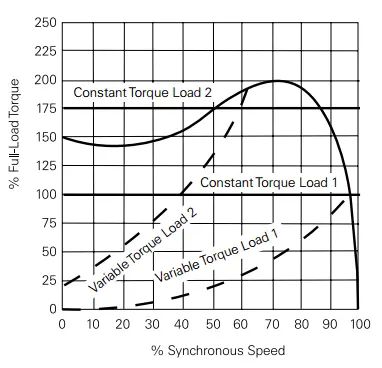Here are the most frequently asked interview questions on Variable frequency drives (VFD/VSD). This article aims to cover most of the interview questions on induction motors so as to prepare you to crack a job interview.
Interview questions on variable frequency drives
- What is a VFD?
- How does a variable frequency drive work?
- What is the difference between VFD and Soft Starters?
- What are the different types of breaking methods used in a VFD?
- What is meant by dynamic braking or DBR?
- What is meant by regenerative braking?
- What are the different types of loads?
- List out few constant torque applications:
- List out few variable torque applications:
- Constant torque curve vs Variable torque curve
- What is meant by slip?
- What is slip compensation?
- How do you select a VFD?
- What is meant by sensorless vector control?
- What is the role of encoders?
- What is meant by DC injection breaking?
- Briefly explain the VFD commissioning procedure.
- What are harmonics?
- What are the harmonics mitigation techniques?
- What are the advantages of VFD?
What is a VFD?
Variable frequency drives/ variable speed drives/ VFD/ VSD are all one and the same. They are used to control the speed of rotation of a motor by regulating the frequency and voltage of the electric motor’s input power supply. The speed of the motor can be controlled precisely using a variable frequency drive.
How does a variable frequency drive work?
A variable frequency drive comprises a rectifier, filters, an inverter, switching, and control circuits. Input to the VFD is usually a three-phase AC supply. This three-phase input supply is rectified and converted into DC voltage by the rectifier. This DC voltage is again converted into a Three-phase AC voltage of required frequency and threshold by the inverter.
What is the difference between VFD and Soft Starters?
| Soft starter | Variable Frequency Drives |
|---|---|
| Soft starters are used to start and stop a motor smoothly. | Variable Frequency Drives are used to start, stop and control a motor throughout its operation |
| Most of the time soft starters are bypassed as soon as the motor reaches its full speed. | Variable frequency drives to control a motor throughout its operation |
| No harmonics | Harmonics are injected into the mains. He |
What are the different types of breaking methods used in a VFD?
Two types of braking methods are used in variable frequency drives: Dynamic resistive braking and Regenerative braking.
What is meant by dynamic braking or DBR?
Dynamic braking is a technique by which energy regenerated by a motor is dissipated as heat in braking resistors. When the power to the motor is cut off or when the load torque is more than the motor torque, the motor acts as a generator and the generated energy is dissipated across the braking resistors. The resistors used for this purpose is known as dynamic braking resistors.
What is meant by regenerative braking?
In regenerative braking, instead of dissipating the energy in the resistors, it is fed back to the mains. A regenerative braking unit is connected to the DC bus of the VFD which converts the regenerated energy into AC and feeds it backs to the mains.
What are the different types of loads?
There are two types of loads: Constant torque load and variable torque load.
Constant torque loads: The load torque characteristic does not depend on the speed. The load torque
remains approximately the same over the whole speed area.
Variable or quadratic Torque loads: The load torque is proportional to the square of the speed and power increases as the cube of speed.
Impact loads: These loads demand intermittent torque. Example: Punch press.
List out few constant torque applications:
- cranes
- elevators
- ski lifts
- escalators
- and conveyors
List out few variable torque applications:
- Pumps
- Fan

